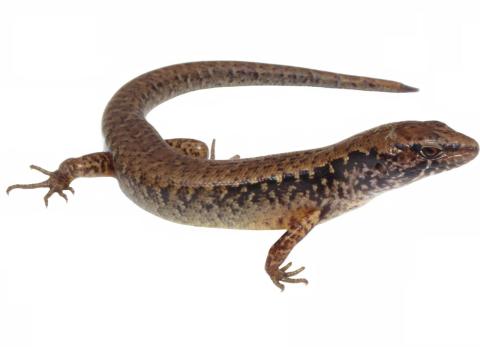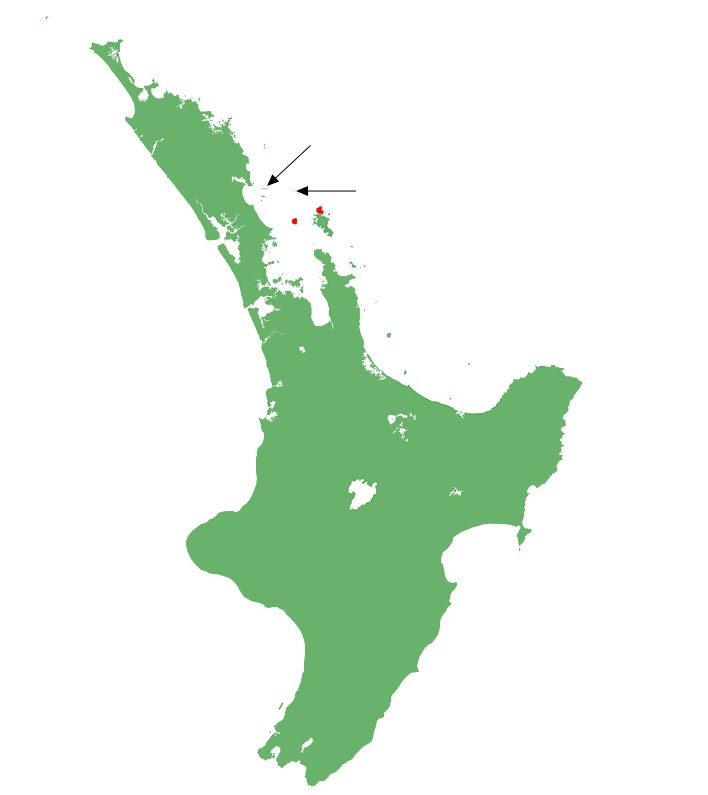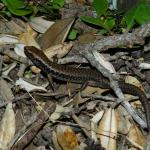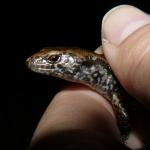- Home
- Herpetofauna Index
- Native
- Oligosoma Townsi
Oligosoma townsi
Hauraki skink
Oligosoma townsi
(Chapple et al., 2008)

Length: SVL up to 95mm, with the tail being equal to the body length
Weight: unknown
Description
A beautiful, intricately marked skink restricted to several islands within the Hauraki Gulf, including the Hen and Chicken Islands. It is closely related to the marbled skink (Oligosoma oliveri), Coromandel skink (Oligosoma pachysomaticum), and Whitaker's skinks (Oligosoma whitakeri).
They are characterised by their dark brown through to tan brown dorsal (upper) surfaces, which are covered with cream and black flecking. The lateral surfaces (sides) have a marbled appearance, being heavily blotched with black and cream/white markings, particularly over the front half of the body. The ventral (lower) surfaces are cream, grey, or light orange. Black flecking is heavy on the throat fading onto or absent from the stomach. As with the other members in the marbled skink complex, a distinctive black-edged teardrop is present under the eye, as well as varying degrees of a denticulate (tooth-like) patterning along the lips.
Geographically isolated from the closely related marbled, Whitaker’s skink (Oligosoma whitakeri), and Coromandel skinks (Oligosoma pachysomaticum). Differentiated from ornate skinks by the heavy dark blotching on the lateral surfaces, as well as by the much larger size and more robust build.
Life expectancy
Largely unknown, however, other Oligosoma species have been recorded reaching ages of over ten years in the wild, whilst the closely-related Whitaker's skink (Oligosoma whitakeri) has been reported to live for 55+ years in captivity (D. Keall, personal communication, May 22, 2021).
Distribution
Confined to several islands in the Hauraki Gulf including Aotea/Great Barrier Island, Hauturu/Little Barrier Island, the Hen and Chicken group, and the Mokohinau group.
Ecology and habitat
The Hauraki skink is nocturnal in nature, with crepuscular (dawn and dusk) tendencies, although gravid females are known to bask during the day. As with most Oligosoma, they are terrestrial (ground-dwelling), spending the majority of their time foraging on the forest floor/amongst coastal vegetation.
Being restricted to island ecosystems this species is often associated with the coastal forest, scrub, and shrubland that dominates them. In particular, this species is associated with areas of deep leaf litter, rock-covered coastal grassland, and the honeycomb-like systems of burrows that occur within the large petrel colonies.
Social structure
The Hauraki skink is generally considered to be solitary in nature, although they may be found inhabiting the same refugia as congeners. Males are likely to show aggressive behaviour towards other males, especially during the breeding season. Neonates (babies) are independent from birth.
Breeding biology
Much like the closely-related marbled skink (Oligosoma oliveri), the Hauraki skink is viviparous, probably giving birth to 2-4 live young around March/April. As is the case with many lizard species, mating in Oligosoma may seem rather violent with the male repeatedly biting the female around the neck and head area. Sexual maturity is probably reached between 2-4 years.
Diet
Hauraki skinks are omnivores. They are primarily insectivorous in nature, but are known to feed on the nectar, and small fruits of several plant species when they are seasonally available. Being terrestrial in nature, their invertebrate prey tends to be predominantly composed of ground beetles, spiders, weta, and other ground-dwelling invertebrates.
Disease
The diseases and parasites of Aotearoa's reptile fauna have been left largely undocumented, and as such, it is hard to give a precise determination of the full spectrum of these for many species.
The Hauraki skink, as with other Oligosoma species, is a likely host for at least one species of endoparasitic nematode in the Skrjabinodon genus (Skrjabinodon trimorphi), as well as at least one strain of Salmonella. In addition to this, it is thought to be a host for at least one species of ectoparasitic mite in the Ophionyssus genus.
Conservation strategy
DOC classify this species as 'At Risk - Recovering' (Hitchmough et al. 2021). Hauraki skinks are not being actively managed and are present in moderate to high numbers on several of the Hauraki gulf islands. Accordingly, they are at no immediate risk of extinction.
The vast majority of populations occur on pest-free islands, however, the population occurring on Aotea/Great Barrier Island is exposed to mammalian pests (rats, feral cats, pigs etc.), and habitat degradation, which has resulted in the population becoming severely compromised, and at imminent threat of extinction. As such this population should be targeted for focussed, and immediate predator-control efforts in order to maintain the health of this population.
Interesting notes
Named after the renowned herpetologist David Towns. Accordingly, Hauraki skinks are sometimes referred to as Town’s skink.
The marbled skink species-complex has proven especially difficult to resolve because genetic traits have often suggested a different evolutionary scenario than what other (morphological, ecological and biogeographical) traits imply, and as a result the taxonomy of the complex has been much debated and somewhat unstable for the past thirty years. The definition of the marbled skink has thus changed from its original concept of a Poor Knights Islands endemic (McCann 1955), to a species widespread among various islands from the Poor Knights south to the Coromandel Peninsula area (Hardy 1977), to one found on the Poor Knights and Coromandel areas but not in between (Chapple et al. 2008), and eventually back to its original Poor Knights Islands only concept (Jewell 2019).
The Hauraki skink sits within clade 4 (the teardrop skink complex) of the Oligosoma genus, with the marbled, Coromandel and Whitaker's skink being their closest relatives within the group.
References
McCallum, J. (1980). Reptiles of the northern Mokohinau Group. Tane, 26, 53-59.
McCallum, J., & Harker, F. R. (1982). Reptiles of Little Barrier Island. Tane, 28, 21-27.
van Winkel, D., Baling, M., & Hitchmough, R. (2018). Reptiles and Amphibians of New Zealand: A Field Guide. Auckland University Press, pp 376.
Hauraki skink in coastal boulder field (Hauturu / Little Barrier Island). © Tim Harker



